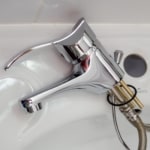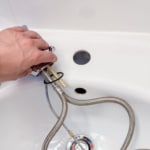Your Faucet Is Loose? (Common Causes & Simple Solutions)
Turn on the water, turn off the water – many times a day.
Kitchen and bathroom fittings are in constant use.
It may well happen that the faucet becomes loose over time.
Sometimes a faulty assembly or a forgotten component is to blame.
But also years of limescale deposits may lead to fittings, mixer levers and handles beginning to wobble at some point.
This article will tell you how to fix the problem yourself depending on the type of fitting.
Contents
Wobbly fittings – the cause
To get to the bottom of the problem of loose fittings, you should first know how they are fixed.
Regardless of whether it is a washbasin or a sink unit: in most cases, fittings are placed in the middle of a pre-drilled hole through which the hoses are threaded.
In order for the faucet to hold, it must be tightened. There are basically two ways of doing this: above or below the wash basin or sink.
Newer fittings in particular are often screwed on top of the sink.
There is usually a grub screw on the base of the faucet that you can easily tighten with an Allen key.
However, many older faucets are fixed with nuts underneath the sink. The exact type of screw connection depends on whether it is a bathroom or kitchen fitting.
The fitting in the bathroom wobbles – what to do?
Bathroom fittings are usually fixed below the washbasin with nuts that are screwed onto one or two threaded rods.
Two washers serve as a buffer between the nut and the ceramic of the wash basin.
In some cases, the nuts were not tightened properly during assembly or only tightened by hand after the fitting was aligned.
However, they can also loosen through years of use or too much pressure on the faucet.
If there is enough space under the wash basin, you can tighten the nuts with a normal wrench or a ratchet wrench with a suitable nut.
The problem: washbasins are often so tightly built that there is no space for conventional tools.
In this case, a faucet wrench is the best choice.
This is equipped with a long, thin rod so that you can also reach nuts that are difficult to access.
Models with a swiveling lever provide additional flexibility in the smallest of spaces.
What to do if the nuts cannot be tightened?
If the fittings are leaky, limescale can build up on the threaded rods – especially if the water is very hard.
This may lead to the nuts no longer being able to be screwed tight.
To descale the threaded rods, proceed as follows:
- Turn off the water using the angle valves under the fitting.
- Open the faucet to allow any remaining water to drain. To be on the safe side, you should also put a towel under the wash basin.
- Unscrew the hoses of the fitting from the angle valves.
- Unscrew the nut from the threaded rod. If there is little space under the washbasin, we recommend using a faucet wrench or an elongated nut.
- Pull the fitting and hoses off the washbasin.
Now you can unscrew the threaded rod from the faucet and remove limescale.
If there is rust, it is advisable to spray the rod with a special rust remover.
Of course, you can also equip your fitting with a new thread or rod – if it is a branded fitting and spare parts are available.
The faucet in the kitchen is loose – cause and solution
Kitchen fittings are fixed in a similar way to their counterparts in the bathroom.
However, it can be observed that they start to wobble faster than bathroom fittings.
This is due to the material: particularly thin, inexpensive kitchen sinks made of sheet steel offer less stability than solid washbasins.
Kitchen fittings are also fixed below the sink with washers and one or two nuts.
In addition, there is a so-called stabilization triangle made of plastic, also called faucet hole reinforcement.
This ensures that the pressure of the tightened nuts is distributed more evenly on the sink to prevent the material from deforming.
If the kitchen faucet wobbles uncontrollably, this component was probably forgotten during assembly and you should retrofit it.
Stabilization triangles are available online and in hardware stores. If you choose a one-size-fits-all model, you can even save yourself measuring.
To assemble, proceed as follows:
- Remove all disturbing objects under the sink.
- Lie on your back under the sink. You may need a flashlight to see the screw connection.
- Loosen the nut from the threaded rod. The best way to do this is to use a faucet wrench.
- Remove the nut and washers.
- Now place the stabilizing triangle between the sink and washers before you hand-tighten the nut.
Caution: Before you tighten the nuts, do not forget to center the faucet in the hole.
The fitting should no longer have any play. Do not tighten too much to avoid damaging the nuts.
Prevent wobbling with stabilizing plates
If you use a thin sink in combination with a heavy kitchen faucet, it may be worthwhile to attach a stabilizing plate.
Thanks to its thick material, this ensures that the faucet is held firmly in place. The plates are not expensive and are simply screwed to the underside of the kitchen sink.
If you want to prevent wobbly fittings, it is best to opt for a high-quality sink when planning your kitchen.
Well-known manufacturers such as Grohe and Blanco offer stainless steel sinks that even heavy faucets can easily hold onto.
Mixing lever is loose
If the lever on your single-lever mixer wobbles, the screw has probably come loose. To tighten it again, first turn off the water using the angle valves.
The lever is screwed to the cartridge with a small grub screw that controls the hot and cold water. Most of the time, a blue/red cap is attached to the screw, which you must first pry off with a thin screwdriver.
Now you can tighten the screw again with a suitable Allen key.
If the lever still has too much play, the plastic cartridge inside the fitting is probably worn out.
The handle of the fitting is loose
If the handles on your two-handle faucet are loose and move too easily, it is likely due to years of wear and tear.
The locking bushing inside the handle may no longer grip the cap properly and must be replaced.
Sharing is caring 🙂 !
[addtoany]




